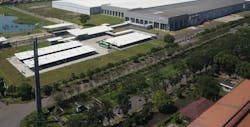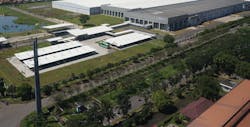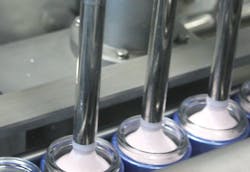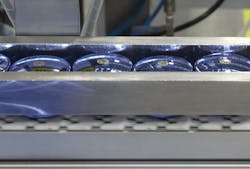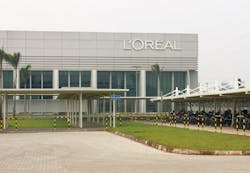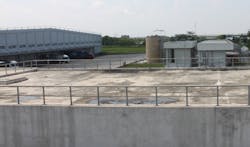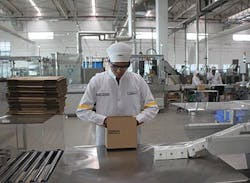Spanning an impressive 66,000 square meters of prime industrial land, L’Oreal Manufacturing Indonesia is the 43rd and largest factory owned by the L’Oreal Group worldwide. Located within the Jababeka Industrial Estate in West Java, the plant supports L’Oreal’s tremendous growth in the Southeast Asian beauty market, manufacturing hair and skin care products under its mass-market brands, L’Oreal Paris and Garnier.
“The L’Oreal Group chose to invest in Indonesia as the country has the highest growth potential in Asia Pacific,” said Ari Cahyo Saputro, environment, health and safety manager for L’Oreal Manufacturing Indonesia. “This investment supports our goal of reaching one billion new consumers within the next ten years. At the moment, 30 percent of our products are manufactured for the domestic market while the other 70 percent is distributed to other countries in the Southeast Asian region.”
The First LEED-Silver-Certified Plant in Indonesia
A world-class facility designed with environmental sustainability in mind, L’Oreal Manufacturing Indonesia is the first factory in the country to receive the Leadership in Energy and Environmental Design (LEED) Silver Certification. LEED-certified companies are recognized internationally with the premier mark of achievement in ‘green building,’ and commonly cost less to operate as they derive savings garnered from their environmental efforts.
Working toward LEED certification was an important venture for L’Oreal. The L’Oreal Group has in recent years rigorously stepped up efforts to reduce its environmental footprint through better waste and water management. The company has a worldwide goal to reduce absolute carbon dioxide (CO2) emissions by 60 percent by 2020, and the LEED award for L’Oreal Manufacturing Indonesia was a positive affirmation that L’Oreal was well on its way to achieving its ambitious target.
“Receiving this certification was a strong encouragement for us at L’Oreal,” Saputro said. “It motivated us to explore more efficient ways to manage the plant and our resource consumption.” Saputro said L’Oreal was also keen to implement a complete wastewater treatment plant onsite to promote smarter management of wastewater discharge. “By doing so, we will be better able to achieve our environmental sustainability goals.”
Managing Wastewater to Achieve Sustainability
In a bid to achieve its environmental sustainability objectives, L’Oreal Manufacturing Indonesia was keen to address and introduce solutions for safe wastewater disposal. L’Oreal Manufacturing Indonesia then turned to its partner Veolia, a global professional water solutions provider, to help design and implement a complete wastewater treatment plant for L’Oreal’s new facility. As Veolia had partnered with L’Oreal on other projects before, it was a natural choice for the cosmetics giant to engage Veolia for this effort.
“L’Oreal first started working with Veolia in Asia Pacific back in 2007, and we have enjoyed a good partnership since, as both companies have similar commitments to environmental sustainability,” Saputro explained. “Veolia was able to deliver on all accounts and it was a pleasant experience on a whole, as they were able to satisfy our interest to minimize our environmental footprint. It was ideal then for us to consult Veolia, a trusted and competent partner.”
As a one-stop water service provider, Veolia was also able to add value to the project by providing all the water solutions required. “Since Veolia was closely involved in another of L’Oreal’s wastewater plants in Suzhou, we had a good understanding of what the Indonesian plant might require,” said Fenian Feng, a process engineer with Veolia. “We helped L’Oreal to achieve its environmental commitment by optimizing wastewater management in this plant, specifically to reduce transportable waste and limit CO2 emissions.”
Veolia Uncovers Water Challenges
After a thorough analysis, Veolia identified the water challenges that L’Oreal Manufacturing Indonesia faced. “The wastewater had a low flow rate, high concentration levels of oil and grease, and also contained high concentration levels of chemical oxygen demand (COD), which implied a higher level of organic pollutants in the wastewater,” Feng said.
The wastewater from the cosmetic manufacturing plant mostly contained organic industrial waste matter and therefore needed a special pretreatment process before discharge. The high concentration of suspended solids and fats present in the wastewater also required a longer time to decompose due to its complex components.
“We have to limit our COD levels in the wastewater to 800 parts per million (ppm) to comply with local regulations in order to receive a discharge permit,” said Dian Ayu, an environmental engineer with L’Oreal Manufacturing Indonesia. “After Veolia analyzed our wastewater, we realized that our COD levels were as high as 15,000 ppm, while soluble COD concentration levels were around 3,000 ppm. So, our challenge was to treat the effluent to control and bring the levels down.”
Triple-Combination Solution
Taking all these factors into consideration, Veolia designed and proposed a complete wastewater treatment plant that featured three of its advanced water technologies: the Idrocos™ Dissolved Air Flotation (DAF) system; AnoxKaldnes™ Moving Bed Bioreactor (MBBR); and HydroTech™ DrumFilter, specially customized for a user-friendly, low-maintenance system.
A pretreatment unit for oil and grease removal, Idrocos DAF comprises an online coagulation injection followed by a flocculation step before the clarification phase to clarify water using dissolved air. This step separates any suspended solids, oil and grease, and hydrocarbons from the wastewater, and it can remove up to 99 percent of undissolved COD. The AnoxKaldnes MBBR is then integrated to remove the dissolved COD from the DAF outlet. Using biofilm-coated carriers, MBBR stabilizes discharge quality and optimizes the water tank for future tertiary treatment and reclaim.
Lastly, the implementation of the HydroTech DrumFilter replaces the need for a traditional secondary clarifier. A self-cleaning filter designed to achieve high water-sludge separation performance, the DrumFilter features a small footprint and provides a larger filter area to promote higher efficiency levels, while achieving minimized energy costs and a low carbon footprint.
“In addition to meeting the standards set by the local municipal body, Veolia’s proposed wastewater treatment plant was also specially customized to meet L’Oreal’s requirements for a compact wastewater plant,” Feng said. With that consideration, Veolia recommended technologies such as the DrumFilter as it featured a small footprint.”
Building on L’Oreal’s Sustainability Legacy
Armed with an intimate understanding of L’Oreal Manufacturing Indonesia’s manufacturing processes and wastewater challenges, Veolia was able to fully support the cosmetic giant as it continues to integrate sustainability practices into its business model. “I believe that our service standard and existing good relationships won us this project with L’Oreal,” Feng said. “As an established water solutions provider, Veolia was able to stand out from the crowd as we had the expertise and technologies required to meet L’Oreal’s needs.”
“Using Veolia’s recommended water technologies, we managed to reduce our energy consumption, chemicals usage, and sludge production,” Saputro concluded. “By taking care of how we dispose of our wastewater, L’Oreal is sending a strong corporate message that cements our commitment to environmental sustainability. With the help of like-minded partners such as Veolia, we are confident that we will be able to mitigate new challenges that come our way.”
Veolia is a global leader in optimized resource management. With over 200,000 employees worldwide, the company designs and provides water, waste and energy management solutions that contribute to the sustainable development of communities and industries. Veolia Water Technologies specializes in technological solutions and design-build projects for water and wastewater treatment, serving industrial and municipal clients.
